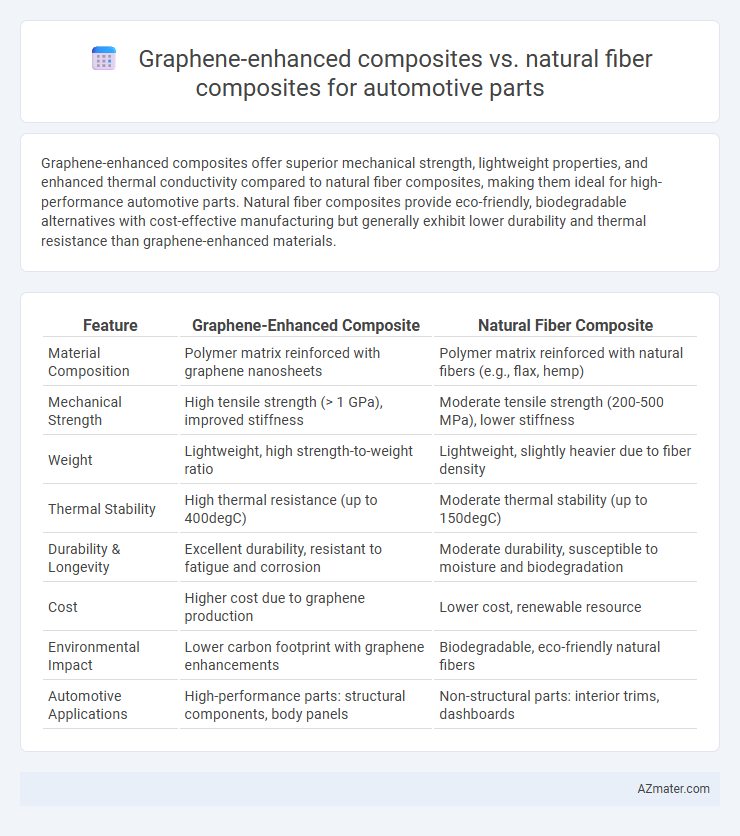Graphene-enhanced composites offer superior mechanical strength, lightweight properties, and enhanced thermal conductivity compared to natural fiber composites, making them ideal for high-performance automotive parts. Natural fiber composites provide eco-friendly, biodegradable alternatives with cost-effective manufacturing but generally exhibit lower durability and thermal resistance than graphene-enhanced materials.
Table of Comparison
| Feature | Graphene-Enhanced Composite | Natural Fiber Composite |
|---|---|---|
| Material Composition | Polymer matrix reinforced with graphene nanosheets | Polymer matrix reinforced with natural fibers (e.g., flax, hemp) |
| Mechanical Strength | High tensile strength (> 1 GPa), improved stiffness | Moderate tensile strength (200-500 MPa), lower stiffness |
| Weight | Lightweight, high strength-to-weight ratio | Lightweight, slightly heavier due to fiber density |
| Thermal Stability | High thermal resistance (up to 400degC) | Moderate thermal stability (up to 150degC) |
| Durability & Longevity | Excellent durability, resistant to fatigue and corrosion | Moderate durability, susceptible to moisture and biodegradation |
| Cost | Higher cost due to graphene production | Lower cost, renewable resource |
| Environmental Impact | Lower carbon footprint with graphene enhancements | Biodegradable, eco-friendly natural fibers |
| Automotive Applications | High-performance parts: structural components, body panels | Non-structural parts: interior trims, dashboards |
Introduction to Automotive Composites
Automotive composites have evolved as critical materials that offer enhanced strength-to-weight ratios and improved fuel efficiency. Graphene-enhanced composites provide exceptional mechanical properties and electrical conductivity by integrating graphene nanoplatelets into polymer matrices. Natural fiber composites present sustainable alternatives with lower environmental impact, combining plant-based fibers such as flax or hemp with thermoplastic resins for lightweight, biodegradable automotive components.
Overview of Graphene-Enhanced Composites
Graphene-enhanced composites in automotive parts exhibit superior mechanical strength, electrical conductivity, and thermal stability compared to natural fiber composites. The integration of graphene nanosheets significantly improves impact resistance and wear properties while maintaining lightweight characteristics crucial for vehicle efficiency. These composites offer enhanced durability and multifunctionality, making them ideal for high-performance automotive applications requiring advanced material engineering.
Natural Fiber Composites in Automotive Applications
Natural fiber composites are increasingly favored in automotive applications due to their biodegradability, lightweight properties, and cost-effectiveness compared to graphene-enhanced composites. These composites, often derived from flax, hemp, or jute, contribute to reduced vehicle weight and improved fuel efficiency while maintaining adequate strength and flexibility. Advances in surface treatments and hybridization have enhanced the mechanical performance and durability of natural fiber composites, making them a sustainable alternative for interior panels, door trims, and dashboards.
Mechanical Properties Comparison
Graphene-enhanced composites exhibit significantly higher tensile strength, stiffness, and impact resistance compared to natural fiber composites, making them more suitable for high-performance automotive parts. The incorporation of graphene improves load transfer and fracture toughness, resulting in superior mechanical durability and fatigue resistance. Natural fiber composites, while lighter and more sustainable, generally demonstrate lower mechanical strength and are prone to moisture absorption, affecting long-term performance in automotive applications.
Weight Reduction and Lightweighting Benefits
Graphene-enhanced composites offer superior weight reduction benefits compared to natural fiber composites due to their exceptional strength-to-weight ratio and stiffness, enabling thinner and lighter automotive parts without compromising structural integrity. Natural fiber composites provide moderate lightweighting advantages and are favored for their sustainability, but typically require thicker sections to achieve comparable mechanical performance to graphene composites. Incorporating graphene into composites enhances durability and reduces overall vehicle weight, directly improving fuel efficiency and lowering emissions in automotive applications.
Impact Resistance and Durability
Graphene-enhanced composites exhibit superior impact resistance and durability compared to natural fiber composites, making them ideal for automotive parts subjected to high stress and collision risks. The incorporation of graphene significantly improves tensile strength, fatigue resistance, and energy absorption, resulting in longer service life and enhanced safety performance. Natural fiber composites, while lightweight and eco-friendly, generally offer lower impact resistance and degrade faster under harsh environmental conditions, limiting their durability in critical automotive applications.
Manufacturing Processes and Scalability
Graphene-enhanced composites offer superior mechanical strength and electrical conductivity, enabling faster curing times and improved process control in manufacturing compared to natural fiber composites, which rely on traditional molding and lay-up techniques. The scalability of graphene composites is currently challenged by higher material costs and complex dispersion methods, whereas natural fiber composites benefit from abundant raw materials and established industry adoption facilitating large-scale production. Advancements in graphene functionalization and hybrid processing are progressively addressing these manufacturing and scalability limitations for automotive part integration.
Environmental Sustainability and Life Cycle Analysis
Graphene-enhanced composites exhibit superior mechanical strength and durability compared to natural fiber composites, resulting in longer service life and reduced replacement frequency in automotive parts. Natural fiber composites offer significant advantages in environmental sustainability due to their biodegradability, lower carbon footprint, and renewable resource base, contributing to reduced end-of-life impact. Life cycle analysis reveals that while graphene composites require energy-intensive production processes, their improved performance and recyclability can offset environmental costs over the vehicle's operational lifespan.
Cost Efficiency and Economic Considerations
Graphene-enhanced composites offer superior mechanical properties and durability at a higher initial cost compared to natural fiber composites, which provide cost-effective and sustainable solutions with lower material expenses. The integration of graphene can reduce maintenance and extend vehicle part lifespan, potentially offsetting upfront costs through long-term savings in automotive manufacturing. Natural fiber composites benefit from renewable sourcing and energy-efficient processing, making them economically favorable for large-scale production despite lower performance metrics.
Future Trends and Market Outlook
Graphene-enhanced composites are gaining traction in the automotive industry due to their superior strength-to-weight ratio, electrical conductivity, and thermal stability compared to natural fiber composites. Market projections indicate a growing demand for graphene composites driven by their potential to improve vehicle performance while meeting stringent environmental regulations. Future trends suggest increased integration of graphene materials in lightweight structural components, promoting enhanced durability and fuel efficiency across automotive manufacturing.

Infographic: Graphene-enhanced composite vs Natural fiber composite for Automotive part
 azmater.com
azmater.com